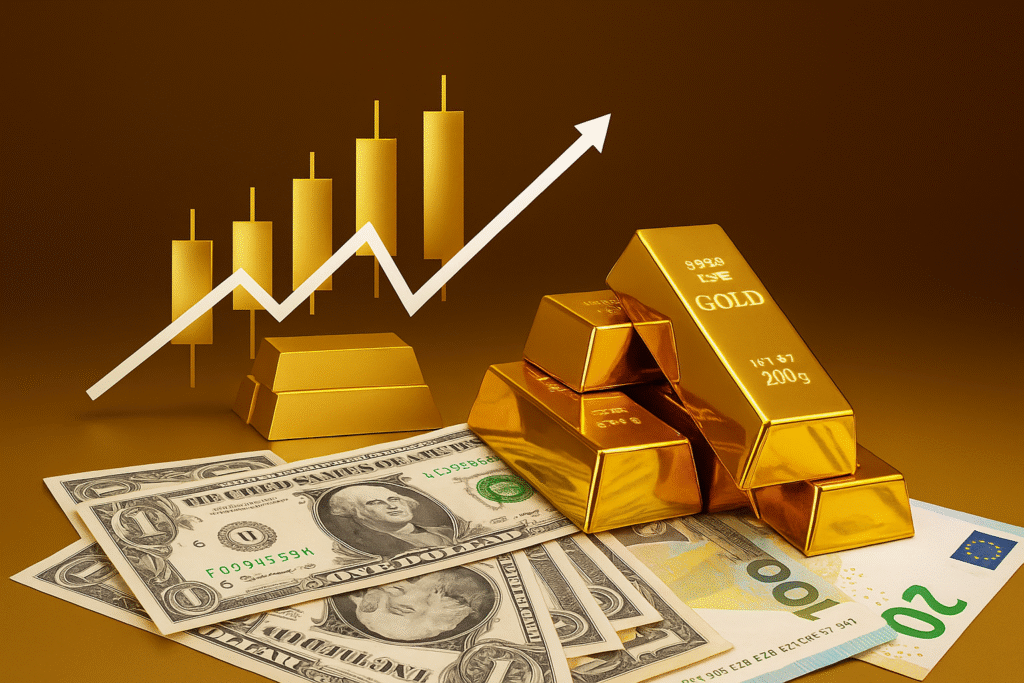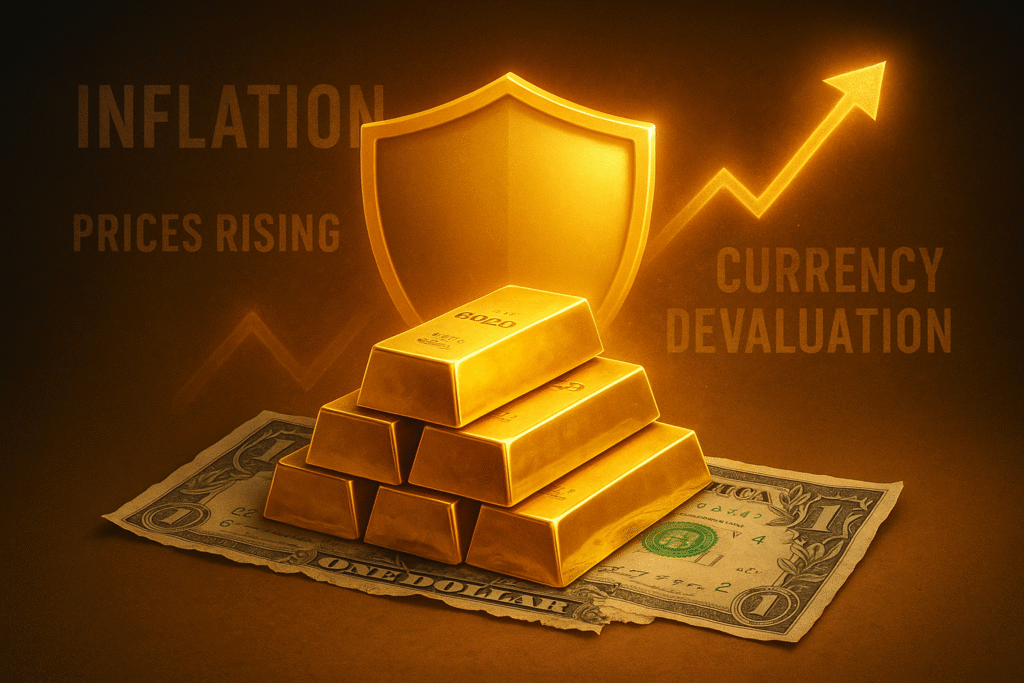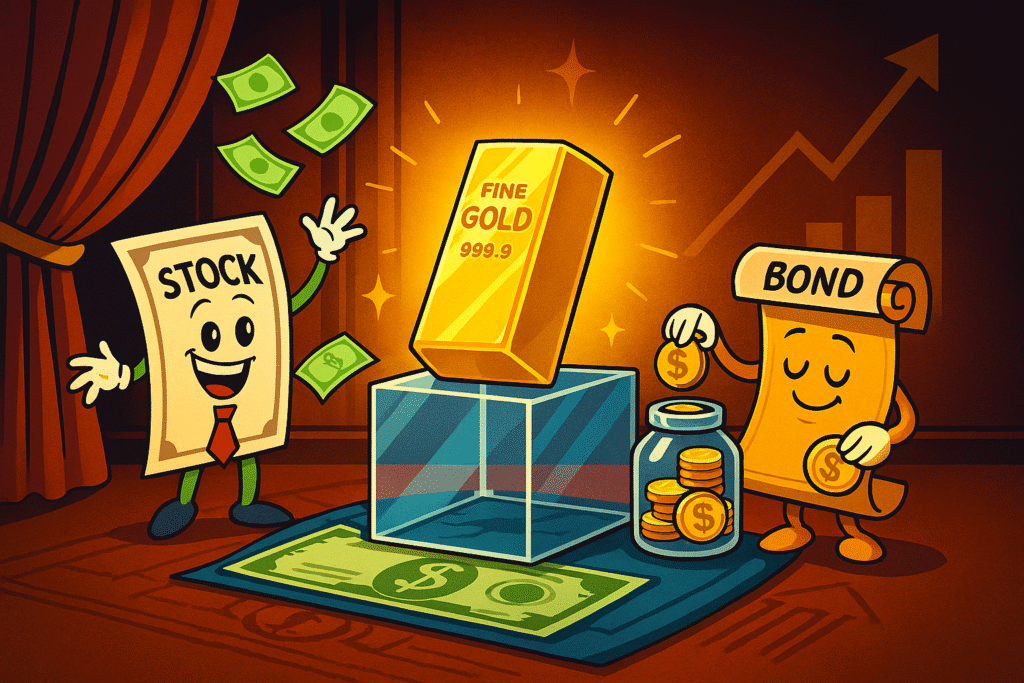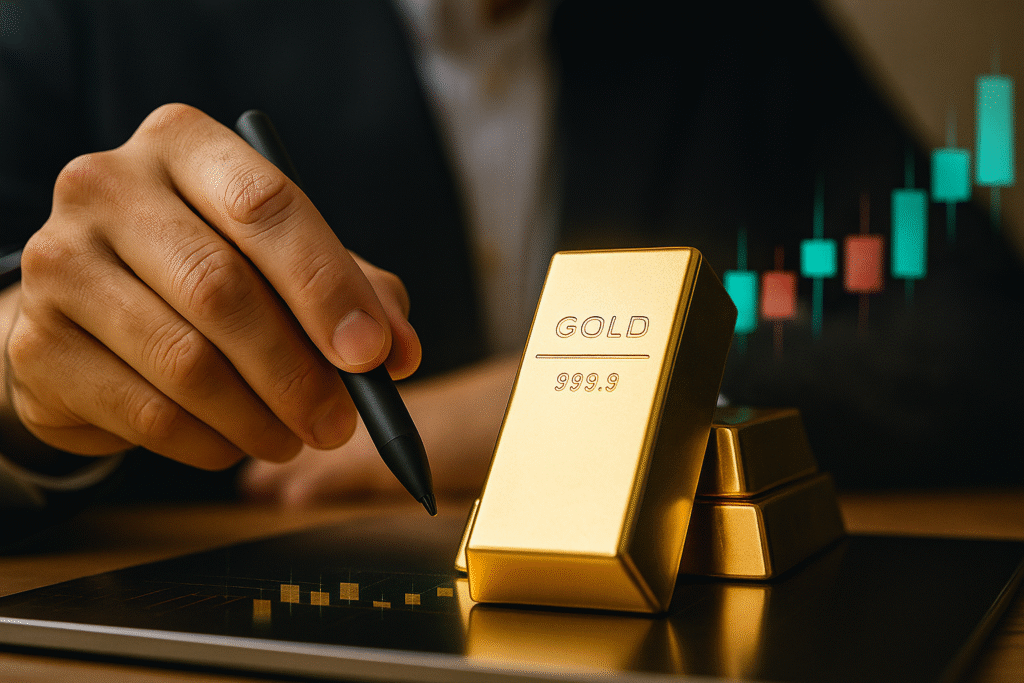Ever wonder why your uncle won’t stop talking about his gold stash at every family dinner? With the stock market going haywire and inflation hitting 7.3% this month, maybe the old man’s onto something after all. In times of economic chaos, investing in gold—often touted as a rock-solid gold investment—starts to sound less like paranoia and more like smart strategy.
Let’s cut through the noise and figure out if investing in gold is worth it in today’s economy—or if it’s just another shiny object distracting you from real wealth-building. Ultimately, evaluating gold as investment means weighing its historic resilience against modern-day financial goals.
The truth about gold investments isn’t black and white. For some, it’s been a fortress against economic chaos. For others, it’s been dead money sitting in a safe while other investments soared.
What most financial advisors won’t tell you about gold might surprise you – especially when we compare its performance during the last three market crashes.
Understanding Gold as an Investment

The Historical Significance of Gold in Financial Markets
Gold isn’t just a shiny metal—it’s been humanity’s go-to safe haven for thousands of years. Dating back to ancient Egypt around 3000 BCE, gold became the first recognized medium of exchange. Remarkably, while empires rose and fell, gold remained valuable. For anyone investing in gold today, that historical resilience reinforces gold as investment with enduring trust and relevance.
During the Gold Standard era (1870s-1971), major currencies were directly backed by gold. Your dollar was literally worth its weight in gold! When the system collapsed in 1971 (the “Nixon Shock”), gold prices soared from $35 to over $800 by 1980.
What makes gold special? Unlike paper money, governments can’t just print more of it. There’s a finite supply, with only about 201,296 tons ever mined in human history. Most currencies have crashed at some point – but gold has never gone to zero.
Different Ways to Invest in Gold (Bullion, ETFs, Mining Stocks)
Got the gold bug? You’ve got options: from physical bullion to ETFs, mining stocks, and IRAs. Learn more about adding gold to your portfolio.
Physical Gold: The classic approach: gold bars and coins you can actually hold. No middleman, no counterparty risk. It’s the most tangible form of investing in gold—and for many, the appeal of buying gold lies in that physical assurance. The downside? Storage costs, insurance, and authentication concerns.
Gold ETFs: Think of these as “gold by proxy.” Each share represents a fraction of gold, tracking its price without the hassle of storage. Popular options include SPDR Gold Shares (GLD) and iShares Gold Trust (IAU). They’re liquid, convenient, but come with management fees.
Mining Stocks: Investing in companies that pull gold from the earth. These can outperform gold itself during bull markets thanks to operational leverage. The flip side? They face business risks beyond just gold prices – management decisions, production costs, geopolitical issues.
Gold Futures & Options: For sophisticated investors, these derivatives offer leverage. Small movements in gold prices can mean big profits (or losses).
Here’s how they stack up:
| Investment Type | Pros | Cons |
|---|---|---|
| Physical Gold | Direct ownership, privacy, no counterparty risk | Storage costs, insurance, liquidity challenges |
| Gold ETFs | Liquidity, ease of trading, minimal storage concerns | Management fees, counterparty risk |
| Mining Stocks | Potential outperformance, dividends | Company-specific risks, volatility |
| Futures & Options | Leverage, hedging capabilities | Complexity, expiration dates, higher risk |
Gold’s Role in a Diversified Portfolio
Gold shines brightest when everything else is falling apart.
During the 2008 financial crisis, the S&P 500 plunged 38% while gold gained 5.5%. In 2020’s COVID crash, when markets tanked in March, gold held relatively steady before climbing to all-time highs. It’s no surprise then that gold as investment continues to thrive when everything else seems to unravel—investing in gold often becomes a financial lifeline in times of market mayhem.
The magic happens because gold typically moves differently than stocks and bonds. When they zig, gold often zags. Financial nerds call this “negative correlation,” and it’s portfolio gold (pun intended). Consequently, investing in gold—or treating gold as investment—can be a clever way to smooth out the bumps in an otherwise volatile ride.
Most financial advisors suggest a 5-10% allocation to gold, depending on your risk tolerance and investment horizon. That’s enough to provide meaningful protection without sacrificing too much long-term growth.
Gold also offers protection against inflation. While cash loses purchasing power when prices rise, gold has historically maintained its value over centuries. Here’s why gold is considered an inflation hedge.
Current Market Trends in Gold (As of 2025)
Gold has been on quite a journey since 2023. After breaking $2,000/oz in 2023, it reached new heights in early 2025, hovering around $2,450 as I write this.
What’s driving this rally? Several factors:
- Persistent inflation concerns despite central banks’ aggressive monetary policies
- Geopolitical tensions in Eastern Europe and the Middle East
- Central bank buying at record levels, particularly from China, Russia, and India
- De-dollarization efforts by BRICS+ nations seeking alternatives to USD reserves
The digital gold revolution is also gaining steam. Tokenized gold assets on blockchain have surpassed $18 billion in market cap, making gold more accessible to younger investors.
Mining production has plateaued around 3,000 tons annually, with analysts suggesting we may have hit “peak gold” – the maximum extraction rate possible with current technology.
Looking forward, Goldman Sachs projects gold could reach $3,000 by end of 2026, while more conservative estimates from JP Morgan target $2,700. Either way, the outlook remains bullish as economic uncertainty persists.
The Advantages of Investing in Gold

A. Hedge Against Inflation and Economic Uncertainty
Gold has historically served as a powerful shield when inflation starts eating away at your dollar’s purchasing power. Think about it – while governments can print money endlessly (hello, inflation!), nobody can create more gold out of thin air.
When central banks go on printing sprees, gold typically shines. During the 2008 financial crisis, gold prices jumped nearly 24% while the S&P 500 crashed 38%. And during the COVID-19 pandemic economic uncertainty? Gold hit all-time highs. Accordingly, investing in gold—especially as gold as investment—often proves its worth when fiat currencies face credibility crises.
Look at the data from the last 50 years—during periods of high inflation, gold prices have typically moved in the opposite direction of the dollar’s purchasing power. That’s exactly what you want in an inflation hedge, and it’s one of the core reasons many turn to investing in gold during turbulent economic times.
B. Portfolio Diversification Benefits
Smart investors know not to put all their eggs in one basket. Gold moves differently than stocks and bonds – that’s what makes it so valuable in a portfolio.
When stocks tank, gold often climbs. During the 2020 market crash, while the Dow dropped over 30%, gold prices rose nearly 15%.
Gold’s correlation with other asset classes is historically low:
| Asset Class | Correlation with Gold |
|---|---|
| US Stocks | 0.02 (almost none) |
| Bonds | 0.19 (very weak) |
| Real Estate | 0.15 (very weak) |
This means gold ziggs when other investments zagg—perfect for smoothing out those portfolio bumps. Learn how to use gold in your portfolio.
C. Protection During Market Volatility
Market crashes happen. Black Monday, the dot-com bubble, 2008, 2020 – they’re inevitable. During these white-knuckle moments, gold often provides a safe harbor.
The numbers tell the story. During the five worst market downturns since 1970, gold averaged a positive return of 9.7% while stocks plummeted.
Gold’s price stability comes from its universal demand. Even when stock markets are in free fall, gold’s industrial uses and global demand as jewelry remain relatively stable.
The best part? When volatility spikes and fear grips the market, investors instinctively rush to gold, often driving its price even higher – exactly when you need that protection most.
D. Tangible Asset with Intrinsic Value
Unlike stocks or cryptocurrency, gold is something you can actually hold in your hand. There’s something powerfully reassuring about that.
Gold has maintained its value for thousands of years. Roman emperors, medieval kings, and modern investors all recognized its worth. Meanwhile, countless currencies and investments have completely disappeared.
Gold has real-world uses beyond investment – electronics, dentistry, aerospace, and jewelry all depend on gold’s unique properties. This gives gold an intrinsic value floor that purely financial assets simply don’t have.
Even if financial systems collapse, gold retains value. That’s why preppers and sophisticated investors alike keep some physical gold in their possession. Here’s how gold fits into prepping strategies.
E. Global Acceptance and Liquidity
Gold speaks every language and is welcomed in every country. Try selling obscure stocks in a foreign country – now try selling gold. See the difference?
Gold markets never close. While stock exchanges have set hours, gold trades 24/7 somewhere in the world. Therefore, you’re never locked in when unexpected news breaks overnight. For those investing in gold, this around-the-clock accessibility is a key advantage of gold investing in today’s hyper-connected economy.
The gold market is massive—about $170 billion in gold changes hands daily. This incredible liquidity means you can convert substantial amounts to cash without moving the market price. For those considering investing in gold, this kind of flexibility makes gold investing especially attractive compared to more volatile assets.
Central banks worldwide hold over 35,000 metric tons of gold reserves. They’re not stockpiling beanie babies or NFTs – they’re holding gold because it represents true, lasting wealth across borders and political systems.
The Drawbacks of Gold Investments

A. Limited Income Generation (No Dividends or Interest)
Gold just sits there, looking pretty. Unlike stocks that pay dividends or bonds that generate interest, your gold bar won’t drop a penny into your pocket while you own it.
This is a major drawback that many investors overlook in their gold rush. When you buy 10 ounces of gold today, you’ll still have exactly 10 ounces five years from now—no more, no less. Meanwhile, dividend-paying stocks might have grown your initial investment by 15–20% through dividend payments alone. See how gold compares to the stock market.
Think about it: $10,000 in a dividend stock yielding 3% annually puts $300 in your pocket each year. That same $10,000 in gold? Zero passive income.
For retirees or anyone looking to generate regular cash flow from their investments, gold’s income silence can be deafening.
B. Storage and Insurance Costs
Owning physical gold isn’t as simple as stashing it under your mattress (please don’t do that).
Gold comes with ongoing expenses that eat into your potential returns. Consider these real costs:
- Safe deposit boxes: $50-$300 annually
- Home safes: $500-$2,000 upfront
- Insurance premiums: 0.5-2% of gold value annually
- Security systems: $200-$1,500 plus monthly monitoring
I recently spoke with an investor who spent over $3,000 in five years just to store and protect his $25,000 gold investment. That’s 12% of his investment value gone without adding a single ounce. Clearly, while investing in gold offers security, gold as investment can come with hidden costs that eat into long-term gains.
Even gold ETFs and funds charge annual management fees (typically 0.25-0.75%), constantly nibbling away at your investment.
C. Price Volatility Despite “Safe Haven” Status
Gold’s reputation as a “safe haven” is one of investing’s greatest myths.
The reality? Gold prices can swing wildly. In 2013, gold plummeted nearly 30% in value. Between 2011 and 2015, it dropped over 40%. More recently, in March 2020, when markets crashed due to COVID-19 fears, gold initially fell alongside stocks – precisely when its “safe haven” status should have shined brightest.
Daily price movements of 1–3% are common. For perspective, that’s similar volatility to many blue-chip stocks. It’s a reminder that while investing in gold can provide stability in the long term, gold investment still comes with its own share of short-term swings.
This volatility makes gold particularly tricky for short-term investors or those with specific time horizons for their financial goals. Explore the best time horizons for gold investing.
D. Potential for Market Manipulation
The gold market isn’t as transparent as you might think.
With fewer regulations than stock markets, gold prices can be influenced by large players making concentrated moves. In 2014, five banks were fined billions for manipulating gold benchmark prices.
Central banks, which hold about 20% of all above-ground gold, can dramatically shift prices with their buying and selling decisions. When they sneeze, the gold market catches a cold.
Even perception matters enormously. A single tweet from an influential figure can send prices soaring or plunging within hours.
This manipulation risk means you’re not just betting on gold’s intrinsic value – you’re gambling on the actions of powerful market participants whose interests may not align with yours.
Comparing Gold to Other Investment Options

Gold vs. Stocks and Bonds
Gold behaves differently than traditional paper assets. While stocks and bonds generate income through dividends and interest, gold typically doesn’t produce cash flow. It’s all about appreciation.
When markets crash, gold often shines. During the 2008 financial crisis, the S&P 500 dropped 37%, but gold gained 5.5%. Talk about zigging when others zag!
But here’s the catch – over very long periods, stocks have historically outperformed gold. The S&P 500’s average annual return hovers around 10%, while gold delivers closer to 7.5% long-term.
Consider this comparison:
| Feature | Gold | Stocks/Bonds |
|---|---|---|
| Income generation | None | Dividends/Interest |
| Volatility | Moderate | High (stocks), Low (bonds) |
| Inflation protection | Strong | Variable |
| Storage costs | Yes | No |
Gold vs. Real Estate
Real estate and gold both offer tangible asset protection, but they couldn’t be more different operationally. Similarly, while property may generate income, investing in gold—or considering gold as investment—leans more on long-term preservation than active returns.
Property generates rental income and potentially appreciates. Gold just sits there looking pretty until you sell it. That’s the trade-off with investing in gold—unlike real estate, gold as investment doesn’t produce cash flow, but it can shine when other assets stumble. Compare gold vs. real estate here.
Real estate requires active management, maintenance, and dealing with tenants. Gold needs… a safe spot.
Tax implications differ dramatically too. Real estate investors enjoy numerous deductions and depreciation benefits that gold owners simply don’t get.
The liquidity gap is massive. You can sell gold in minutes, while real estate transactions take weeks or months.
Both can hedge inflation, but real estate offers practical utility that gold can’t match. Nobody’s living inside a gold bar!
Gold vs. Cryptocurrencies
Gold and crypto both position themselves as alternatives to fiat currency, but the similarities mostly end there.
Gold has a 5,000-year track record as a store of value. Bitcoin launched in 2009. That’s quite the experience gap.
Volatility differences are stark. Gold might move 1–2% on a wild day. Crypto can swing 10–20% before lunch. For those exploring gold as investment, this relative calm is one of the key attractions—investing in gold offers a level of stability that digital assets rarely match.
The technology barriers differ too. Anyone can buy and hold physical gold. Crypto requires digital wallets, exchange accounts, and technical know-how. Here’s how gold stacks up against Bitcoin.
Both assets have scarcity built in – gold through natural limits, Bitcoin through its 21 million coin cap.
Here’s how they stack up:
| Feature | Gold | Cryptocurrencies |
|---|---|---|
| Age | Ancient | Since 2009 |
| Volatility | Low-moderate | Extremely high |
| Regulatory status | Well-established | Evolving |
| Storage concerns | Physical security | Digital security |
| Energy consumption | Mining impacts | High (for proof-of-work) |
Gold vs. Other Precious Metals
Gold isn’t the only shiny metal in town. Silver, platinum, and palladium each offer distinct investment characteristics.
Silver tends to follow gold’s price movements but with greater volatility – like gold’s more excitable younger sibling. It has more industrial uses, making its price partially tied to manufacturing demand.
Platinum and palladium are primarily industrial metals used in catalytic converters and electronics. Their prices can swing dramatically based on automotive industry health.
Gold maintains the highest value-to-weight ratio, making it more practical for large investments. You’d need a much bigger vault for equivalent silver holdings!
The liquidity hierarchy is clear: gold markets are deepest, followed by silver, then platinum and palladium. This matters when you need to sell quickly without price impact.
During market stress, gold typically outperforms other precious metals as investors flock to the most recognized safe haven. Consequently, investing in gold remains a top choice for those seeking reliable protection, reinforcing gold investment as a strategic move in turbulent times.
Strategic Approaches to Gold Investment

Determining the Right Allocation in Your Portfolio
Gold isn’t just shiny—it’s a financial shield when markets go haywire. But how much should you actually own? Most financial advisors suggest keeping gold to about 5–10% of your total portfolio. Any more and you’re potentially sacrificing growth; any less and you might not get meaningful protection. Striking that balance is key when considering investing in gold, especially if you’re treating it as a long-term hedge rather than just dabbling in gold investing.
Your perfect allocation depends on:
- Your risk tolerance (nervous investors often sleep better with more gold)
- Your investment timeline (longer horizons can handle less gold)
- Current economic conditions (inflation fears? Maybe bump it up)
A smart approach? Start with 5% and adjust based on your comfort level and market conditions. Remember that gold doesn’t pay dividends or interest—it just sits there looking pretty until someone pays more for it than you did. Here’s how to decide how much gold belongs in your portfolio.
Timing Your Gold Investments
Trying to perfectly time gold purchases is a fool’s errand – even the experts get it wrong constantly. But that doesn’t mean you should buy blindly.
Gold typically shines brightest during:
- Periods of high inflation
- Times of geopolitical uncertainty
- Stock market downturns
- Currency devaluation
The dollar-cost averaging strategy works beautifully with gold. Instead of dumping all your money at once, spread purchases over time. This smooths out your entry price and removes the stress of trying to catch the perfect moment.
Watch these signals before buying:
- Gold/silver ratio (above 80 historically indicates undervalued gold)
- Real interest rates (negative rates typically boost gold)
- Central bank policies (easing often benefits gold prices)
Tax Implications of Different Gold Investment Methods
The IRS doesn’t treat all gold investments equally, and this matters big time for your returns.
Physical gold (coins, bars, jewelry) gets taxed as a collectible – up to 28% on gains for most investors. That’s significantly higher than the 15-20% long-term capital gains rate on stocks.
Gold ETFs that hold physical gold also face that higher collectible tax rate. But gold mining stocks? They get standard capital gains treatment.
Here’s how different methods stack up tax-wise:
| Investment Type | Tax Classification | Max Federal Tax Rate |
|---|---|---|
| Physical Gold | Collectible | 28% |
| Gold ETFs (physical) | Collectible | 28% |
| Gold Mining Stocks | Capital Asset | 20% (long-term) |
| Gold Futures | 60/40 Rule | 23.8% (blended) |
Gold in retirement accounts like IRAs sidesteps immediate taxation, but you’ll need a special self-directed IRA for physical gold, which comes with added costs and storage requirements. Nevertheless, for those serious about investing in gold, weaving gold as investment into a retirement strategy can offer both tax advantages and meaningful diversification. Learn more about Gold IRAs here.
Long-term vs. Short-term Gold Investment Strategies
Short-term gold trading is essentially gambling with slightly better odds. The price swings can be brutal, and timing entry/exit points perfectly requires either incredible luck or a crystal ball.
For short-term plays (under a year):
- Technical analysis becomes your best friend
- Set strict stop-loss orders to limit downside
- Focus on gold-backed ETFs for liquidity
- Be prepared for heart-stopping volatility
Long-term gold holding (5+ years) tells a completely different story. Gold has maintained purchasing power for literally thousands of years. It doesn’t care about stock market crashes, housing bubbles, or cryptocurrency meltdowns.
For long-term strategies:
- Physical gold makes more sense (coins or small bars)
- Storage security becomes paramount
- Dollar-cost averaging reduces timing pressure
- Rebalancing annually keeps your overall allocation on target
The historical sweet spot? Gold performs exceptionally well during extended periods of economic uncertainty and inflationary environments. If those conditions match your economic outlook, increasing your allocation makes sense.
Expert Insights on Gold’s Future Prospects

Economic Factors Influencing Gold Prices
Gold isn’t just shiny—it’s a financial barometer. When inflation heats up, investors flock to gold like seagulls to a dropped sandwich. In 2024, we saw this play out dramatically as inflation peaked at 4.2% in Q1, sending gold prices soaring past $2,500 per ounce.
Interest rates and gold have this weird relationship—like that couple who’s always fighting but can’t break up. When rates drop, gold typically climbs. The Fed’s recent pivot to lower rates starting in late 2024 gave gold a nice boost.
The US dollar’s strength also plays a huge role. When the dollar weakens (as it did through much of 2024-early 2025), gold tends to flex its muscles. Foreign buyers suddenly find gold more affordable, and demand shoots up.
Here’s how these factors have been moving the needle:
| Economic Factor | Current Impact | Expected Future Impact |
|---|---|---|
| Inflation | Strong positive | Moderately positive |
| Interest Rates | Strong positive | Strongly positive |
| Dollar Strength | Positive | Moderately positive |
| Economic Uncertainty | Very positive | Remains positive |
Technological Developments Affecting Gold Demand
The tech sector’s relationship with gold is changing faster than smartphone models. Traditional electronics manufacturing still gobbles up about 8% of global gold supply, but new technologies are creating fresh demand streams. For those investing in gold, this evolving dynamic highlights how gold investment is increasingly influenced by innovation, not just tradition.
Green tech is the surprise gold-lover nobody saw coming. Solar panels now incorporate gold nanoparticles to boost efficiency—and with solar installations booming 35% year-over-year, that’s a significant gold sink. Beyond its sparkle and security, investing in gold now taps into industrial demand too, adding yet another layer of relevance to gold as investment in the modern economy.
Medical tech is another gold-hungry field. Gold nanoparticles are revolutionizing cancer treatments, with targeted therapies that precisely attack tumor cells. The medical gold market grew 22% in 2024 alone. Explore the latest research on gold in medical applications.
But recycling technologies are the plot twist in this story. Advanced recovery methods now extract up to 98% of gold from electronic waste. With e-waste growing three times faster than the world’s population, recycled gold is becoming a major supply source, potentially dampening demand for newly mined gold.
The quantum computing sector also has its eye on gold. These next-gen machines use gold components for their superconducting circuits, and as quantum computing scales up, so might gold demand.
Geopolitical Considerations for Gold Investors
Gold thrives on chaos—that’s just the cold, hard truth. The ongoing tensions between major powers have been like rocket fuel for gold prices. The Russia-Ukraine conflict entering its fourth year, continued Middle East instability, and U.S.-China trade frictions have all pushed investors toward safer havens.
Central banks worldwide have been loading up on gold like it’s going out of style. In 2024, central bank purchases hit 850 tonnes—the second-highest annual total ever recorded. China, Russia, and India led the charge, reducing their dependency on dollar-denominated assets.
Trade policies are reshaping gold flows globally. New tariffs on precious metals, especially between Western nations and Asian manufacturing hubs, have created interesting arbitrage opportunities but also complicated the international gold market.
Regulatory changes are worth watching too. The EU’s new Gold Provenance regulations are making waves, requiring detailed sourcing information for all gold imports. This has temporarily constricted some supply chains but is ultimately promoting more ethical mining practices.
Political stability in major gold-producing nations like South Africa and Peru remains shaky. Labor disputes and resource nationalism continue to threaten supply, potentially supporting higher prices in the coming years.
Analyst Predictions for Gold Performance Through 2025-2030
Wall Street’s gold forecasts are far from uniform—but if one trend is clear, it’s this: major institutions are leaning bullish on gold over the next several years. With persistent inflation, geopolitical unrest, and central banks aggressively buying bullion, analysts see gold playing an increasingly vital role in investor portfolios.
What Are the Big Banks Saying?
Goldman Sachs has revised its forecast, projecting gold could hit $4,000 per ounce by mid-2026, driven by central bank demand and recession fears.
JP Morgan echoes this optimism, expecting gold to reach $3,675 by the end of 2025, with the potential to surpass $4,000 if macroeconomic pressures persist.
Citigroup, meanwhile, takes a more cautious stance, warning that if inflation subsides faster than expected, gold could pull back to the $2,500–$2,700 range by late 2026.
HSBC anticipates average prices of $3,015 in 2025 and $2,915 in 2026, highlighting continued geopolitical risk as a key driver.
Moody’s predicts that gold will breach $3,000 by the end of 2026, citing mounting recession concerns and long-term investor rotation toward safe havens.
Forecast Summary: What to Expect
| Timeframe | Gold Price Range | Key Drivers |
|---|---|---|
| 2025–2027 | $3,500–$4,000+ | Inflation, central bank buying, recession risk |
| 2028–2030 | $3,000–$3,500 (stabilization) or higher | Supply constraints, macro uncertainty, weakening fiat currencies |
Analysts broadly agree on 5–12% annual growth through 2027, although the 2028–2030 window presents two scenarios: either price stabilization if global markets normalize, or a renewed rally if gold supply tightens and demand remains robust.
The Supply-Side Factor
Mining analysts are also watching closely. Global gold production is expected to decline after 2027 as major deposits deplete and fewer new discoveries come online. This looming scarcity could further support prices, especially if demand holds steady or increases.
In short, gold’s long-term trajectory appears solid—especially if inflation, geopolitical risk, and central bank accumulation continue to dominate headlines. Investors looking to hedge or diversify may find the next five years particularly golden.
Final Thoughts

Weighing the various aspects of gold investment reveals it’s neither a perfect investment nor one to be dismissed. Indeed, gold offers significant portfolio diversification, inflation protection, and stability during market volatility—benefits that become particularly valuable during economic uncertainty. However, its lack of income generation, storage challenges, and sometimes unpredictable price movements mean it shouldn’t dominate your investment strategy. For those considering buying gold, understanding these trade-offs is essential to making it work within a balanced approach.
The most prudent approach is incorporating gold as part of a balanced portfolio, perhaps allocating 5–10% depending on your risk tolerance and financial goals. Whether through physical gold, ETFs, mining stocks, or gold IRAs, the key is selecting methods that align with your investment timeline and objectives. As markets continue to evolve in the coming years, investing in gold—and treating gold as investment rather than just a commodity—reinforces its enduring appeal for thoughtful investors aiming to protect and grow their wealth. Polish your portfolio with gold insights—see what’s shining now on Investillect.

